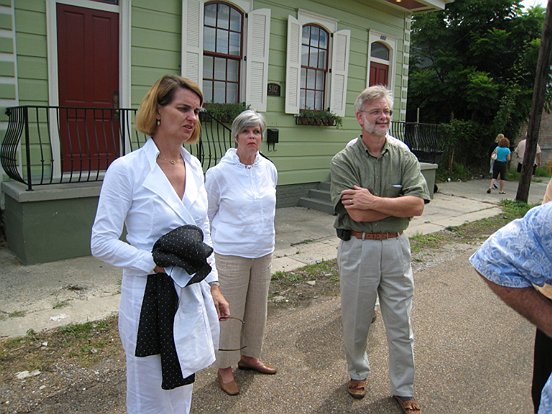
HOME
|
OVERVIEW
|
WORKSHOP OVERVIEW 2008 NOLA ITINERARY |
||
| DAY 1 | ||
|
Upon arrive at the airport our group was met by the City’s Executive Director of the Historic District Landmark Commission, Elliott Perkins. He provided us with an overview bus tour of New Orleans’ neighborhoods affected by the flood waters of Hurricane Katrina. Some areas visited included the location of the levee breach in Lakeside, observing the current reconstruction, deconstruction, in-fill projects and some environmental effects such as the lost of most Magnolia trees due to the flood water. One preservation highlight was the creation of Project Green. Green Project operates a warehouse store that resells high-quality, salvaged building materials at low cost to the community. The store is dedicated to helping the environment by reducing the amount of usable materials placed in landfills or disposed of improperly. Overall the magnitude of the areas affected by the flood water was overwhelming and the work accomplished since 2005 is admirable, but far from complete. Preservation Resource Center of New Orleans |
||
Ms. Bryan provided our group a tour of the PRC offices and bus tour of some of Operation Comeback’s completed projects in Holly Cross and the Lower Ninth Ward. The loss of nearly 1,600 lives in Louisiana was not lost on the group when visiting these areas. |
||
Professor Chambers research although based in the forests of the Amazon, was able to use the models developed in South American to better understand the affects from Hurricane Katrina on the Gulf Coast areas from the climate to the high tree mortality in a bottomland hardwood forest of the Pearl River basin. Following the lost of over 320 million trees it can be seen that the rapidly colonizing of these disturbed areas with the invasive species like the Chinese tallow trees. |
||
|
DAY 2 |
||
The PRC reviewed techniques they help perfect to help save historic structures ravished with mold that otherwise would be demolished. Her non-profit organization and lessons learned from Hurricane Katrina will be invaluable to the National Trust and other national historic districts. Our thoughts immediately turned to the summer flooding in Iowa, Missouri and other areas along the Mississippi River. |
||
She provided an overview of the City’s regional modern architecture with a tour of noted commercial, governmental and even residential examples of New Orleans’ Modern Architecture.
One stop included the residence of an 82-year old architect Albert Ledner. [As luck would be he was working on his roof while we passed by!] His house is one of 40 or so modern but eccentric New Orleans residences he designed including a modern residence built in 1962 for a pair of ardent smokers which has a procession of 1,200 gold glass ashtrays running just below its roofline; it is now the home of the mayor of New Orleans, C. Ray Nagin. |
||
A lunchtime stop may not typically be a cause of inspiration, but our Workshop Chair, Del Acosta selected a location that was equally insightful as the restoration efforts in the City. Café Reconcile was founded by a Jesuit priest and a local developer. Together they have created a place for inner-city youths to develop a vocation in the hospitality industry of New Orleans. In recent years the Food Network and visits by the First Lady Laura Bush has heighted national their successes. |
||
The workshop concluded with a streetcar ride along St. Charles Avenue to the historic Commander’s Palace in the Garden District. The group enjoyed a gourmet five-course dinner in one of their private salons. Following dinner, the Executive Chef Chef, Tory McPhail was able to greet all of us. |
HOME
|
OVERVIEW
The AIA Tampa Bay wishes to express their appreciation for the support of the
2008 NOLA Mobile Workshop to our sponsors: John
Rosende, Jr., Jeld-Wen and
The Molding Depot, Inc.
of
For additional information visit:
www.aiatampabay.com









